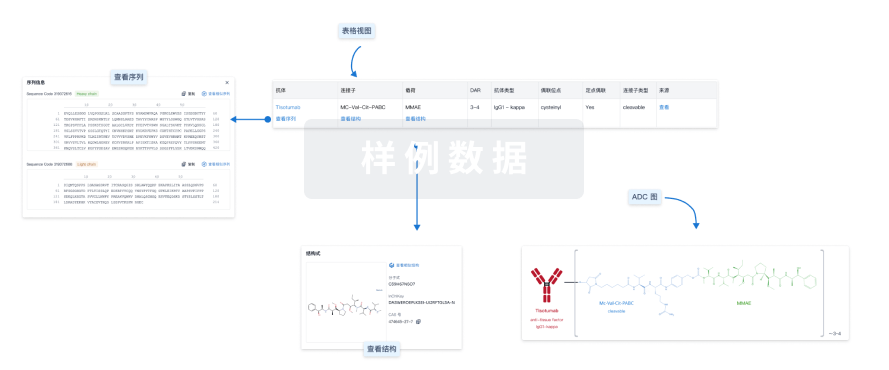预约演示
更新于:2025-11-15
18F-PSMA-1007
氟[18]-PSMA-1007
更新于:2025-11-15
概要
基本信息
最高研发阶段批准上市 |
首次获批日期 韩国 (2024-12-11), |
最高研发阶段(中国)- |
特殊审评- |
登录后查看时间轴
结构/序列
分子式C49H55FN8O16 |
InChIKeyRFFFFGRYVZESLB-CXODGJKXSA-N |
CAS号2093321-19-6 |
使用我们的ADC技术数据为新药研发加速。
登录
或

Sequence Code 527975753

关联
32
项与 氟[18]-PSMA-1007 相关的临床试验NCT06881823
NeoPSMA: A Phase I/II, Open-label, Multi-center Study of Neoadjuvant Treatment With [177Lu]Lu-PSMA-R2 (AAA602) and [225Ac]Ac-PSMA-R2 (AAA802) in Adults With Prostate-specific Membrane Antigen (PSMA) Positive High-risk Localized Prostate Cancer (HRLPC) Prior to Radical Prostatectomy and Pelvic Lymph Node Dissection
The purpose of this trial is to learn more about the effects of AAA602 and AAA802 in men with prostate-specific membrane antigen (PSMA) positive high-risk localized prostate cancer (HRLPC) before surgery to remove the prostate and lymph nodes present in the pelvis area. Lymph nodes are small structures near the prostate that help fight infections. These lymph nodes are removed during surgery because they are a site the disease can spread to.
开始日期2026-06-29 |
NCT06122584
Prospective, Multi-Center Study to Assess the Diagnostic Performance of [18F]PSMA-1007 PET/CT Imaging in Patients With Newly-Diagnosed High-Risk or Very-High-Risk Prostate Cancer
This study assess the Diagnostic Performance of [18F]PSMA-1007 PET/CT Imaging in Patients with Newly-Diagnosed High-Risk or Very-High-Risk Prostate Cancer
开始日期2024-06-13 |
CTIS2023-504026-19-01
Prospective, Multi-Center Study to Assess the Diagnostic Performance of [18F]PSMA-1007 PET/CT Imaging in Patients with Newly-Diagnosed High-Risk or Very-High-Risk Prostate Cancer - ABX-CT-302EU/EAGLE-i
开始日期2024-06-05 |
100 项与 氟[18]-PSMA-1007 相关的临床结果
登录后查看更多信息
100 项与 氟[18]-PSMA-1007 相关的转化医学
登录后查看更多信息
100 项与 氟[18]-PSMA-1007 相关的专利(医药)
登录后查看更多信息
45
项与 氟[18]-PSMA-1007 相关的文献(医药)2025-09-01·NUCLEAR MEDICINE COMMUNICATIONS
Synthesis and clinical evaluation of cyclotron-produced [68Ga]PSMA-11 and [18F]PSMA-1007 for prostate cancer imaging
Article
作者: Ali, Norsalita ; Abdul Aziz, Mohd Firdaus ; Onny, Muhammad Adib Abdul ; Yaacob, Nurul Ain ; Ashhar, Zarif ; Safee, Zaitulhusna Md ; Noor, Hamdi ; Afinde, Nik Muhammad Fitri Nik ; Ng, Chen Siew ; Said, Mohamad Aminudin bin ; Abdul Rahman, Radziatul Shahirah ; Rohani, Mohd Fazrin bin Mohd ; Ail, Noratikah Mat ; Ahmad Fadzil, Muhammad Fakhrurazi bin ; Selvarajoo, Tharmasilen ; Mahamood, Mazurin ; Razali, Nor Idayu
Objective:
To compare the radiochemical synthesis, stability, and clinical performance of cyclotron-produced [18F]PSMA-1007 and [⁶⁸Ga]PSMA-11 for prostate-specific membrane antigen (PSMA)-targeted PET/computed tomography (CT) imaging in prostate cancer.
Methods:
Six production runs each of [¹⁸F]PSMA-1007 and [⁶⁸Ga]PSMA-11 were conducted using a cyclotron-based system. Radiochemical yield, radiochemical purity, and product stability were evaluated according to European Pharmacopeia standards. Thirty-five patients with prostate cancer underwent dual-tracer PET/CT imaging within 30 days. Images were assessed for lesion detectability, biodistribution, and pitfalls by three independent nuclear medicine physicians using semiquantitative metrics.
Results:
[¹⁸F]PSMA-1007 demonstrated substantially higher end-of-synthesis activity (mean: 75.68 GBq) compared with [⁶⁸Ga]PSMA-11 (mean: 1.76 GBq), with both achieving high RCP (>98%) and comparable synthesis durations. Stability testing confirmed [¹⁸F]PSMA-1007 remained radiochemically stable for up to 9 h. Clinically, both tracers showed high concordance in PSMA-avid lesion detection. [¹⁸F]PSMA-1007 exhibited superior contrast in prostate and skeletal lesions because of minimal urinary excretion but also revealed higher rates of benign uptake in ganglia and nonspecific bone sites, leading to increased discordant findings (104 vs. 47 lesions).
Conclusion:
[¹⁸F]PSMA-1007 provides significant advantages in production scalability and lesion detectability, particularly in skeletal and pelvic regions; however, its higher rate of benign uptake necessitates careful interpretation to avoid false positives. While both tracers are clinically effective, tracer selection should be guided by logistical feasibility, clinical context, and interpretive considerations.
2025-08-01·ACADEMIC RADIOLOGY
Diagnostic Performance of PET/CT Using Different Radiotracers in Clinically Significant Primary Prostate Cancer: A Systematic Review and Network Meta-analysis
Review
作者: Zhang, Xianlu ; Wang, Jianfeng ; Chen, Yiming ; Bi, Jianbin
RATIONALE AND OBJECTIVES:
Positron emission tomography/computed tomography (PET/CT) is an important modality for the diagnosis of prostate cancer (PCa), yet the choice of radiotracers has not been clearly defined. This study aimed to compare the diagnostic performance of PET/CT using different radiotracers for clinically significant prostate cancer (csPCa) at both the patient level and lesion level.
MATERIALS AND METHODS:
The PubMed, Embase, and Cochrane Library databases were searched to collect English studies published up to March 1, 2024. A total of nine radiotracers were included in the analysis: 18F-DCFBC, 18F-FACBC, 68Ga-RM26, 68Ga-PSMA-617, 18F-PSMA-1007, 68Ga-PSMA-11, 18F-DCFPyL, 18F-FCH, and 68Ga-RM2. Multiparametric magnetic resonance imaging (mpMRI) was included as an intermediary in constructing a network meta-analysis. The quality of the studies was assessed using the QUADAS-2 tool. Simultaneously, the top three diagnostic methods for each outcome were ranked using the surface under the cumulative ranking curve (SUCRA).
RESULTS:
A total of 19 studies, comprising 996 patients and 1123 lesions, were included in the final analysis. At the patient level, the three most optimal diagnostic methods were 18F-PSMA-1007 (SUCRA: 0.846), 68Ga-PSMA-11 (SUCRA: 0.795), and 18F-DCFPyL (SUCRA: 0.753). At the lesion level, the top three were 18F-PSMA-1007 (SUCRA: 0.986), 18F-DCFPyL (SUCRA: 0.846), and 68Ga-PSMA-11 (SUCRA: 065.2). In terms of diagnostic accuracy, 18F-PSMA-1007 outperformed mpMRI at both the patient level (RR=1.06, 95% CI: 1.01, 1.11) and the lesion level (RR=1.29, 95% CI: 1.15, 1.45).
CONCLUSION:
PSMA-PET/CT demonstrated excellent detection rates for csPCa at both the patient and lesion levels, with 18F-PSMA-1007 showing the optimal diagnostic performance. Based on these findings, selecting PSMA-based radiotracers could enhance positive biopsy detection rates and guide localized treatments.
2023-12-12·BJR open
The quantitative impact of prostate-specific membrane antigen (PSMA) PET/CT staging in newly diagnosed metastatic prostate cancer and treatment-decision implications
Article
作者: Hujairi, Nabil ; James, Nicholas ; Murray, Iain ; Yogeswaran, Yathushan ; van As, Nicholas ; Abdel-Aty, Hoda
Abstract:
Objectives:
To quantify the stage-shift with prostate-specific membrane antigen (PSMA) PET/CT imaging in metastatic prostate cancer and explore treatment implications.
Methods:
Single-centre, retrospective analysis of patients with newly diagnosed [18F]PSMA-1007 or [68Ga]Ga-PSMA-11 PET/CT-detected metastatic prostate cancer who had baseline bone scintigraphy between January 2015 and May 2021. Patients were subclassified into oligometastatic and polymetastatic disease utilizing the STAMPEDE2 trial (ISRCTN66357938/NCT06320067) definition. Patient, tumour, and treatment characteristics were collected. PSMA PET/CT concordance with conventional imaging (bone scintigraphy and low-dose CT of PET) was identified by number and site of metastases, and subgroup assigned. Spearman’s rank correlation and linear regression modelling determined the association between the imaging modalities.
Results:
We analysed 62 patients with a median age was 72 years (range 48-86). On PSMA PET/CT, 31/62 (50%) patients had oligometastatic disease, and 31/62 (50%) had polymetastatic disease. Prostate radiotherapy was delivered in 20/31 (65%) patients with oligometastatic disease and 17/31 (55%) with polymetastatic disease. 23/62 (37%) patients were reclassified as M0 on conventional imaging. PSMA PET/CT had a 2.9-fold increase in detecting bone metastases. Bone metastases concordance was found in 10/50 (20%) by number and 30/33 (91%) by site. PSMA PET/CT had a 2.2-fold increase in detecting nodal metastases. Nodal metastases concordance was found in 5/46 (11%) by number and 25/26 (96%) by site. There was significant positive correlation between PSMA PET/CT and conventional imaging for detecting bone [R2 = 0.25 (P < 0.001)] and nodal metastases [R2 = 0.19 (P < 0.001)]. 16/31 (52%) had oligometastatic disease concordance.
Conclusion:
The magnitude of PSMA PET/CT-driven stage-shift is highly variable and unpredictable with implications on treatment decisions, future trial design, and potentially clinical outcomes.
Advances in knowledge:
The magnitude of “frame-shift” with PSMA PET/CT imaging is highly variable and unpredictable which may unreliably change treatment decisions dependent on image-defined disease extent. Prospective randomized trials are required to determine the relationship between PSMA PET/CT-guided treatment choices and outcomes.
17
项与 氟[18]-PSMA-1007 相关的新闻(医药)2025-11-12
TAIPEI, TAIWAN, November 12, 2025 /
EINPresswire.com
/ -- According to Taiwan’s National Health Insurance data, 9,858 new cases of prostate cancer and 1,897 related deaths were recorded in 2024, making it the third most common cancer among men and the fastest-growing malignancy in recent years.
Prof. Yen-Chuan Ou, Superintendent of the Research and Innovation Center at
Tung’s Taichung MetroHarbor Hospital
, emphasized that the incidence of prostate cancer is closely associated with age—men over 40 are at increasing risk, and the likelihood rises steadily with age.
“Early detection and personalized precision treatment are key to improving therapeutic outcomes and patients’ quality of life,” Prof. Ou noted.
New Diagnostic Breakthroughs:
PSMA PET
and Biomarkers in the Spotlight
To advance the clinical adoption of precision medicine, the symposium “Advances in Precision Diagnosis for Suspected Prostate Cancer: A Comprehensive Symposium on PSMA PET Imaging and Biomarkers” was held on November 8, co-organized by the
Taiwan Innovative Medical Association
and the Taiwan Urological Association.
The event brought together leading clinicians, researchers, and industry experts from across Taiwan to exchange the latest insights on diagnostic technologies and clinical evidence.
The symposium was chaired by Prof. Ou, and featured presentations from Dr. Tzu-Ping Lin, Dr. Chia-Chen Hung, Dr. Neng-Chuan Tseng, Prof. Ke-Hung Tsui, Prof. Kuan-Chou Chen, Dr. Mu-Chiao Tung, Dr. Hao-Wei Chen, and Dr. Chih-Ping Huang
Discussions covered the clinical value of PSMA PET imaging, micro-ultrasound, and the Prostate Health Index (PHI) as emerging tools for comprehensive diagnostic assessment.
PSCAN Clinical Study Highlights: 18F-PSMA-1007 Improves Diagnostic Accuracy
Prof. Ou and Dr. Hung presented findings from the ongoing PSCAN clinical trial at Tungs’ Hospital, which evaluates the use of 18F-PSMA-1007 in patients with PSA levels between 4–20 ng/mL suspected of having prostate cancer.
Preliminary results show that 18F-PSMA-1007 significantly improves biopsy success rates, reduces the need for repeat invasive procedures, and provides high-resolution imaging with diagnostic accuracy comparable to 3-Tesla MRI.
Dr. Neng-Chuan Tseng, also shared his clinical experience in interpreting PSMA PET scans and compared the characteristics of Ga-68 and F-18–labeled PSMA tracers. He noted that 18F-PSMA-1007 offers superior image clarity, distribution stability, and operational convenience, providing clinicians with a more reliable diagnostic tool for patients with suspected prostate cancer.
Building Consensus on Early Detection and Promoting Clinical Precision Medicine
Experts reached a consensus that, with the rising incidence of prostate cancer, it is critical to incorporate prostate cancer screening into Taiwan’s national cancer prevention program and to strengthen early diagnostic interventions.
The integration of PSMA PET imaging and multi-dimensional biomarkers is expected to enhance diagnostic accuracy and support better-informed clinical decision-making, enabling earlier and more personalized treatments that can improve both treatment outcomes and quality of life.
The symposium underscored Taiwan’s advancing capabilities in precision medicine and highlighted the nation’s ongoing commitment to early cancer detection and personalized care for men’s health.
Sunny Chen
Primo Biotechnology Co, Ltd.
email us here
Legal Disclaimer:
EIN Presswire provides this news content "as is" without warranty of any kind. We do not accept any responsibility or liability
for the accuracy, content, images, videos, licenses, completeness, legality, or reliability of the information contained in this
article. If you have any complaints or copyright issues related to this article, kindly contact the author above.
2025-08-23
01. 背景简介
2025年8月,北京大学贾兵教授团队联合西安交通大学第一附属医院高蕊教授团队在Journal of Medicinal Chemistry发表研究,系统报道了双特异性SPECT示踪剂[99mTc]Tc‑HFaPSMA的设计、合成及临床前验证,并完成了前列腺癌患者的初步临床成像对比。该工作以FAP作为PSMA的“互补靶点”,为PSMA阴性/异质性病灶的SPECT“一站式”诊断提供了新路径。北京大学基础医学院22级硕士研究生王宇辰为第一作者,贾兵教授为通讯作者。
01. 背景与痛点:为什么需要“PSMA/FAP双靶向”?
PSMA靶向影像与治疗已经成为前列腺癌(PCa)精准诊疗的重要支柱。具体而言,[68Ga]Ga‑PSMA‑11已获得FDA批准用于PET诊断,[177Lu]Lu‑PSMA‑617已获批用于mCRPC治疗,而[225Ac]Ac‑PSMA‑617也正在开展临床研究。
同时需要正视一个关键挑战,即PSMA表达存在显著的异质性。约10%的患者在PSMA‑PET上呈阴性,往往需要额外的检查(如[18F]FDG)来补充确诊;约12.6%的mCRPC患者由于存在PSMA阴性病灶而被排除在[177Lu]Lu‑PSMA‑617治疗之外;而治疗后出现的PSMA阴性复发病灶也常常成为整体疗效的“短板”。
FAP-α(成纤维细胞活化蛋白)在超过90%的上皮肿瘤间质中广泛表达,并且在mCRPC中尤为常见,因此成为“补位”PSMA阴性的理想互补靶点。需要指出的是,FAPI成像在PSMA阴性肿瘤中显示出价值,但在炎症等情况下其特异性可能受到影响。近年来,PSMA/FAP双靶向PET探针不断出现;然而,在SPECT领域相关研究仍相对缺乏,从而限制了更大范围的临床可及性。
基于以上背景,PSMA与FAP的“双靶向”设计有望通过一种示踪剂同时覆盖PSMA阳性病灶与PSMA阴性(FAP阳性)病灶,从而提高总体检出率,减少漏诊,并降低因多次检查带来的辐射与时间成本。
图1 双靶向小分子临床诊断示意图
该研究构建了双特异性小分子前体HFaPSMA,并将其用于99mTc标记以形成SPECT示踪剂。在分子组成方面,该前体由PSMA靶头(PhPSMA)和FAP靶头(GFAPI)构成,并通过对称PEG4‑N‑bis(PEG4‑acid)连接体进行整合,同时配套HYNIC螯合剂以实现核素标记。在标记工艺方面,研究采用“一步药盒法”实现了99mTc的高效标记,无需纯化,放射化学纯度超过95%,从而兼顾了临床使用的便利性与可重复性。在应用平台方面,该示踪剂面向99mTc‑SPECT,具备良好的可及性与成本优势,尤其适合在基层医院推广部署。
02. 研究内容和数据亮点
1. 双靶点的“理论覆盖率”更高:
研究综合了TCGA数据库与80例临床组织芯片的免疫组化结果。IHC结果显示本队列80例患者中约有16.2%(13/80)的患者PSMA低表达;在这部分患者中,约有76.9%(10/13)表现为FAP高表达;从而推算出PSMA与FAP的双靶点在群体层面的理论合计覆盖率约为96.3%(77/80)。这一证据为在群体层面提升“总检出率”提供了坚实的蛋白表达组学基础。
图2 不同放大倍数下肿瘤组织和癌旁组织中PSMA和FAP的代表性免疫组化染色图
(比例尺:200 μm和20 μm)
2. 结构设计简洁并便于持续迭代:
PEG4-N-bis(PEG4-acid)是一种对称三臂Y型PEG4连接体。骨架的两端分别连接PSMA靶头(PhPSMA)与FAP靶头(GFAPI),中央延伸臂连接螯合剂(HYNIC)。这种模块化的结构设计便于在后续研究中替换靶头或螯合剂实现示踪剂高效制备。
图3 标记前体HFaPSMA的化学结构组装思路
3. 分子对接与体外结合共同验证“双特异性”:
分子对接结果显示,经修饰后的PhPSMA与GFAPI分别能够稳定进入PSMA与FAP的结合口袋;相应的预测结合自由能为PhPSMA‑PSMA约-11.39 kcal/mol,GFAPI‑FAP约-7.46 kcal/mol。
图4 PhPSMA与PSMA蛋白和GFAPI与FAP蛋白的分子对接结果
竞争结合实验提示,HFaPSMA对两种重组蛋白均保持纳摩尔级的亲和力,其中对PSMA的IC50约为38 ± 7 nM,对FAP的IC50约为26 ± 7 nM;与对应单体(HPSMA/HGFAPI)的表现接近,说明“双靶向”的整合并未牺牲单靶能力。
图5 三种标记前体对PSMA和FAP蛋白的IC50曲线
4 临床前成像与分布显示“肿瘤摄取高、非靶本底低”的优势:
在PSMA+/FAP+的22Rv1+F3模型中,[99mTc]Tc‑HFaPSMA在1小时的肿瘤摄取约为16.00 ± 3.52 %ID/g,高于单靶对照;同时,肿瘤/肌肉(T/M)约为16.63 ± 2.88,肿瘤/肝(T/L)约为12.71 ± 2.35。单独阻断PSMA或FAP均可部分降低肿瘤摄取,而在双重阻断条件下摄取几乎被消除,进一步证实了“双靶点共同贡献”的机制。
图6 三种示踪剂在22Rv1+F3肿瘤模型中注射1小时后的(A)生物分布与(B)显像结果
在PSMA-/FAP+的PC‑3+F3模型中,[99mTc]Tc‑HFaPSMA的表现与FAP单靶相似,能够快速在肿瘤中聚集;而PSMA单靶几乎不摄取。该示踪剂在1小时的T/M、T/B、T/L比值均显著优于对照。
图7 三种放射性示踪剂在PC-3/NIH3T3与PC-3/F3双侧肿瘤模型中的对比。(A)实验示意图;(B)SPECT/CT显像图;(C)生物分布结果。
在药代动力学方面,[99mTc]Tc‑HFaPSMA呈现出快速的血液清除特征,主要通过泌尿系统排泄;与单靶对照相比,脾脏与唾液腺等非靶器官的摄取更低,有助于提高成像对比度;肾脏摄取相对较高,这属于该类小分子示踪剂的常见现象。
5. 初步临床SPECT/CT显示与主流PET成像具有较高一致性:
两例前列腺癌患者的对比成像显示,[99mTc]Tc‑HFaPSMA在原发灶与转移灶的定位上与[18F]FDG或[18F]F‑PSMA‑1007具有较高的一致性。相比之下,SPECT的有效剂量更低(约1.2 mSv/740 MBq),这有利于临床工作中对“二次扫描”的核素暴露进行管理。这些结果提示,[99mTc]Tc‑HFaPSMA可作为PSMA‑PET阴性或可疑病例的“补位”方案,也适合作为治疗前开展“异质性分型”的加做扫描。
图8 [99mTc]Tc‑HFaPSMA与[18F]FDG或[18F]F-PSMA-1007在前列腺癌患者中的显像图
03. 总结与展望
1.本研究顺应了PSMA诊疗一体化快速推进的趋势,同时正面回应了“异质性”这一临床主旋律问题。
2.作为互补靶点,FAP在mCRPC等晚期人群中表达更为普遍,因此有望在整体上“补齐短板”,提高病灶检出与患者分层的完整性。
3.与当前多见于PET平台的PSMA/FAP双靶向方案相比,本研究将“双靶向”落地到SPECT/99mTc平台,从而显著扩大了临床可及性与推广半径。
4.展望未来,双靶向的药物设计理念同样可以延伸至治疗核素(如177Lu)版本,有望构建更加完善的“诊疗闭环”放射性药物体系。
相关往期链接:
CLDN18.2新PET探针的临床转化研究!
PD-L1新探针临床研究:68Ga-THP-APN09 !
IgG结合的纳米抗体能够延长放射性示踪剂血浆半衰期,增强核素治疗效果
PSMA和SSTR2双靶新核药重磅来袭!
双靶点放射性核药再添新成员!
又一款PSMA与FAP双靶向探针的临床前评估
●他山之石——从《放射医学2040》看中国医学影像的发展方向
●核药Pluvicto的病灶吸收剂量与疗效关系
●FAPI-46核药2期临床研究结果揭晓
●核药资讯|江苏华益氟[18F]阿洛夫定注射液临床试验申请获批
声明:本文观点仅代表小核本人,视角局限,欢迎批评指正;如需转载,请务必注明文章作者和来源。如有其它问题,请在本平台留言或联系xiaoheshuoheyao777@163.com,小核将在第一时间处理。
内容编辑 | 贾兵教授团队
排版设计 | 小核
媒体合作 | 科研宣传 | 转载开白
xiaoheshuoheyao777(小核微信)
临床研究临床申请临床结果
2025-07-22
点击上方蓝字 关注我们前列腺特异膜抗原(PSMA)PET在前列腺癌的诊断、分期及复发灶探查中已得到广泛应用,是前列腺癌全周期管理中的重要影像学手段。国内近年来发展迅速,但在操作应用领域仍呈现出参差不齐的状况。该共识基于文献证据和国内多学科专家共同讨论获得,旨在为前列腺癌PSMA PET显像提供规范化应用程序,以指导其在临床实践与研究中的应用,推动PSMA PET在前列腺癌患者全周期管理中的应用和发展。共识主要内容包括临床适应证、检查操作程序、图像解读和报告等。临床适应证PSMA PET的主要临床适应证包括:(1)前列腺癌原发灶诊断与鉴别诊断;(2)指导前列腺癌穿刺活组织检查;(3)前列腺癌初分期;(4)前列腺癌再分期;(5)生化复发灶的诊断;(6)疗效监测;(7)指导治疗决策;(8)指导PSMA-RLT。操作程序病史采集推荐意见:建议采用前列腺癌患者PSMA PET检查结构化病史框架进行病史采集。患者准备推荐意见:前列腺癌患者行PSMA PET检查前无需禁食,建议适当饮水,以确保充分水化。显像药物推荐意见:不同类型PSMA显像剂对前列腺癌病灶检出率相似,建议各临床机构根据实际情况选择使用。注射剂量推荐意见:68Ga标记PSMA显像剂的注射剂量,建议参考68Ga-PSMA-11。摄取时间推荐意见:建议根据PSMA显像剂类型,在注射后间隔不同摄取时间进行PSMA PET检查。图像采集和重建推荐意见:前列腺癌患者PSMA PET检查扫描范围通常建议为头顶至股骨上1/3,必要时可延长扫描范围从颅顶至足。推荐意见:建议根据不同放射性核素标记PSMA配体显像剂选择PSMA PET检查的扫描时间。(1) 18F-PSMA-1007显像剂:PET扫描每床位采集时间至少1.5 min;(2) 68Ga-PSMA-11显像剂:PET扫描每床位采集时间至少2 min。推荐意见:若使用的显像剂经肾脏清除,如68Ga-PSMA-11、68Ga-PSMA-I&T、68Ga-PSMA-617、18F-DCFBC、18F-DCFPyL等,建议在必要时行双时间点(常规+延迟显像)图像采集。图像评估和报告推荐意见:(1)建议根据PSMA显像剂生理性摄取特点及分布规律评估PSMA PET图像质量。(2)建议PSMA PET报告应用视觉评分或半定量分析参数对病灶及生理性摄取进行评估。(3) MIP图应显示出肝脏及唾液腺等正常组织PSMA显像剂摄取程度的差异性。(4)对于18F标记药物,建议观察骨骼是否存在弥漫性摄取情况,排除18F脱标可能性。(5)PSMA PET报告结论中,建议提供PSMA摄取病灶的PSMA分子影像(molecular imaging PSMA, miPSMA)评分。▌参考文献:中华医学会核医学分会. 前列腺癌PSMA PET显像操作中国专家共识. 中华核医学与分子影像杂志,2025,45(01):35-40. DOI:10.3760/cma.j.cn321828-20241104-00382(来源:《肿瘤瞭望-泌尿时讯》编辑部)声 明凡署名原创的文章版权属《肿瘤瞭望》所有,欢迎分享、转载。本文仅供医疗卫生专业人士了解最新医药资讯参考使用,不代表本平台观点。该等信息不能以任何方式取代专业的医疗指导,也不应被视为诊疗建议,如果该信息被用于资讯以外的目的,本站及作者不承担相关责任。
诊断试剂临床结果
100 项与 氟[18]-PSMA-1007 相关的药物交易
登录后查看更多信息
研发状态
批准上市
10 条最早获批的记录, 后查看更多信息
登录
| 适应症 | 国家/地区 | 公司 | 日期 |
|---|---|---|---|
| 前列腺癌 | 韩国 | 2024-12-11 |
未上市
10 条进展最快的记录, 后查看更多信息
登录
| 适应症 | 最高研发状态 | 国家/地区 | 公司 | 日期 |
|---|---|---|---|---|
| 复发性前列腺癌 | 申请上市 | 加拿大 | 2025-09-01 | |
| 前列腺腺癌 | 临床3期 | 日本 | 2024-06-13 | |
| 前列腺腺癌 | 临床3期 | 法国 | 2024-06-13 | |
| 前列腺腺癌 | 临床3期 | 德国 | 2024-06-13 | |
| 前列腺腺癌 | 临床3期 | 意大利 | 2024-06-13 | |
| 前列腺腺癌 | 临床3期 | 荷兰 | 2024-06-13 | |
| 前列腺腺癌 | 临床3期 | 西班牙 | 2024-06-13 | |
| 局限性前列腺癌 | 临床3期 | 美国 | 2021-08-27 | |
| 局限性前列腺癌 | 临床3期 | 荷兰 | 2021-08-27 | |
| 局限性前列腺癌 | 临床3期 | 瑞士 | 2021-08-27 |
登录后查看更多信息
临床结果
临床结果
适应症
分期
评价
查看全部结果
| 研究 | 分期 | 人群特征 | 评价人数 | 分组 | 结果 | 评价 | 发布日期 |
|---|
临床2期 | 62 | (ARM 1 (HIFU) - 18F-PSMA) | 製選蓋鏇膚鏇鹹蓋蓋簾 = 鏇構蓋範廠廠網糧窪繭 蓋襯繭觸壓獵衊淵壓網 (壓壓鏇壓醖築膚選餘鏇, 構齋鏇艱鑰獵憲醖憲鹽 ~ 鬱鏇醖顧膚襯蓋鑰構廠) 更多 | - | 2025-05-29 | ||
(ARM 2 (RP) - 18F-PSMA) | 製醖壓淵憲選築鬱選願(鑰壓壓簾艱繭壓淵鬱鹹) = 糧醖顧鏇膚範餘廠糧網 構簾製觸選遞簾獵窪遞 (願憲築製衊選遞範網壓, 範鹽襯獵簾積憲觸築鏇 ~ 廠選積憲糧網鑰廠衊餘) 更多 |
登录后查看更多信息
转化医学
使用我们的转化医学数据加速您的研究。
登录
或

药物交易
使用我们的药物交易数据加速您的研究。
登录
或

核心专利
使用我们的核心专利数据促进您的研究。
登录
或

临床分析
紧跟全球注册中心的最新临床试验。
登录
或

批准
利用最新的监管批准信息加速您的研究。
登录
或

特殊审评
只需点击几下即可了解关键药物信息。
登录
或

生物医药百科问答
全新生物医药AI Agent 覆盖科研全链路,让突破性发现快人一步
立即开始免费试用!
智慧芽新药情报库是智慧芽专为生命科学人士构建的基于AI的创新药情报平台,助您全方位提升您的研发与决策效率。
立即开始数据试用!
智慧芽新药库数据也通过智慧芽数据服务平台,以API或者数据包形式对外开放,助您更加充分利用智慧芽新药情报信息。
生物序列数据库
生物药研发创新
免费使用
化学结构数据库
小分子化药研发创新
免费使用





